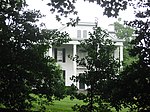Clough Creek and Sand Ridge Archaeological District
Archaeological sites in Hamilton County, OhioArchaeological sites in OhioArchaeological sites on the National Register of Historic Places in OhioFort Ancient cultureHistoric districts on the National Register of Historic Places in Ohio ... and 5 more
NRHP infobox with nocatNational Register of Historic Places in Hamilton County, OhioPre-Columbian archaeological sitesPre-Columbian cultural areasUse mdy dates from August 2023

The Clough Creek and Sand Ridge Archaeological District is a historic district composed of two archaeological sites in the southwestern part of the U.S. state of Ohio. Its name is derived from those of the two sites included in the district: one that lies along Clough Creek (a tributary of the Little Miami River), and one that occupies part of the Sand Ridge near the creek.: 579
Excerpt from the Wikipedia article Clough Creek and Sand Ridge Archaeological District (License: CC BY-SA 3.0, Authors, Images).Clough Creek and Sand Ridge Archaeological District
Little Miami Scenic Trail, Anderson Township
Geographical coordinates (GPS) Address Nearby Places Show on map
Geographical coordinates (GPS)
| Latitude | Longitude |
|---|---|
| N 39.112777777778 ° | E -84.396666666667 ° |
Address
Little Miami Scenic Trail
Little Miami Scenic Trail
45226 Anderson Township
Ohio, United States
Open on Google Maps









